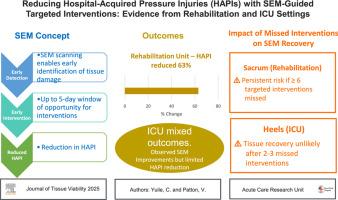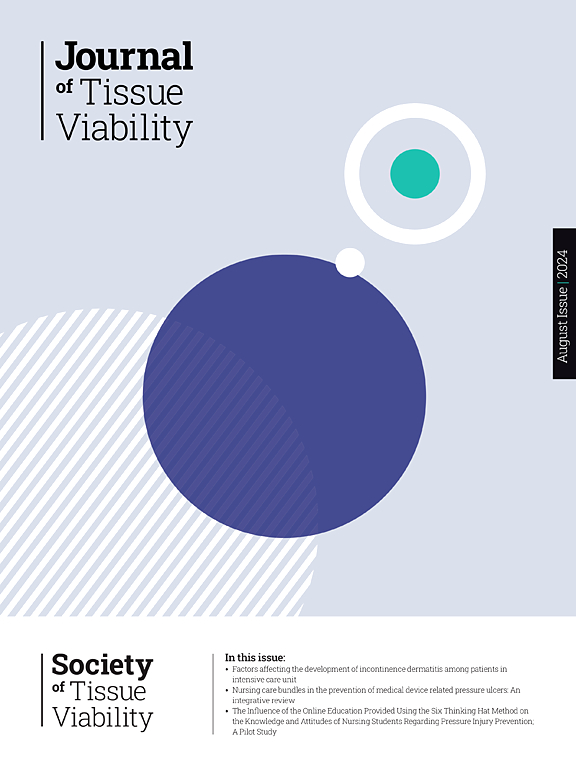Impact of missed interventions on tissue injury outcomes identified via sub-epidermal moisture scanning
IF 2.4
3区 医学
Q2 DERMATOLOGY
引用次数: 0
Abstract
Aim
Sub-epidermal moisture scanning is an emerging tool for the early detection of hospital-acquired pressure injuries. However, the impact of missed interventions following high SEM readings remains underexplored. This study examined the relationship between intervention compliance, missed interventions, and ΔSEM improvement in patients in an intensive care unit and a rehabilitation unit.
Sub-epidermal moisture (SEM) scanning is a validated tool for the early detection of hospital-acquired pressure injuries (HAPIs). However, the impact of missed interventions following high SEM readings remains underexplored. This study examines the relationship between intervention compliance, missed interventions, and ΔSEM improvement in patients from an intensive care unit (ICU) and a rehabilitation unit.
Methods
This prospective observational study was conducted in a metropolitan ICU and a secondary rehabilitation unit in Australia. Daily SEM scanning was conducted alongside standard HAPI prevention measures. A ΔSEM value ≥ 0.6 triggered clinical interventions. Missed interventions were defined as the absence of additional care following a high ΔSEM reading. Descriptive and inferential statistics were used to explore associations between compliance and ΔSEM improvement.
Results
Among 229 patients, including 181 in the rehabilitation unit and 48 in the ICU, high ΔSEM values were observed in 75.5 % and 79.2 % of patients, respectively. SEM-guided interventions were associated with a 63 % reduction in HAPI incidence in the rehabilitation unit and improved ΔSEM outcomes in ICU patients. Three missed interventions resulted in persistent high ΔSEM values in ICU and four in the rehabilitation cohort indicating a potential critical window.
Conclusion
Timely interventions following high SEM readings are critical for improving tissue health and reducing HAPI risk. Further research should explore critical windows for responsive care in different patient cohorts. Scanning protocols and interventions should be tailored to specific clinical environments.

错过干预对通过表皮下水分扫描确定的组织损伤结果的影响
目的表皮下水分扫描是一种新兴的工具,用于医院获得性压力损伤的早期检测。然而,在高扫描电镜读数后错过干预措施的影响仍未得到充分探讨。本研究考察了重症监护病房和康复病房患者的干预依从性、错过干预和ΔSEM改善之间的关系。表皮下水分(SEM)扫描是一种有效的工具,用于医院获得性压力损伤(HAPIs)的早期检测。然而,在高扫描电镜读数后错过干预措施的影响仍未得到充分探讨。本研究探讨了重症监护病房(ICU)和康复病房患者的干预依从性、错过干预和ΔSEM改善之间的关系。方法本前瞻性观察研究在澳大利亚的一个大都市ICU和一个二级康复单位进行。每天进行扫描电镜扫描,同时采取标准HAPI预防措施。ΔSEM值≥0.6触发临床干预。遗漏干预被定义为在ΔSEM高读数后缺乏额外的护理。描述性和推断性统计用于探讨依从性和ΔSEM改善之间的关系。结果229例患者中,分别有75.5%和79.2%的患者ΔSEM值偏高,其中康复病房181例,ICU 48例。扫描电镜引导的干预与康复病房HAPI发生率降低63%相关,并改善了ICU患者的ΔSEM预后。在ICU中,有3个未进行干预,导致ΔSEM值持续高,在康复队列中有4个,表明存在潜在的关键窗口期。结论高扫描电镜读数后及时干预对改善组织健康和降低HAPI风险至关重要。进一步的研究应该探索不同患者群体响应性护理的关键窗口。扫描方案和干预措施应根据具体的临床环境进行调整。
本文章由计算机程序翻译,如有差异,请以英文原文为准。
求助全文
约1分钟内获得全文
求助全文
来源期刊

Journal of tissue viability
DERMATOLOGY-NURSING
CiteScore
3.80
自引率
16.00%
发文量
110
审稿时长
>12 weeks
期刊介绍:
The Journal of Tissue Viability is the official publication of the Tissue Viability Society and is a quarterly journal concerned with all aspects of the occurrence and treatment of wounds, ulcers and pressure sores including patient care, pain, nutrition, wound healing, research, prevention, mobility, social problems and management.
The Journal particularly encourages papers covering skin and skin wounds but will consider articles that discuss injury in any tissue. Articles that stress the multi-professional nature of tissue viability are especially welcome. We seek to encourage new authors as well as well-established contributors to the field - one aim of the journal is to enable all participants in tissue viability to share information with colleagues.
 求助内容:
求助内容: 应助结果提醒方式:
应助结果提醒方式:


